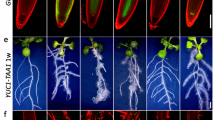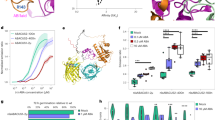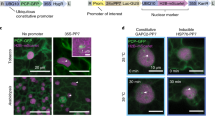Abstract
During multicellular development, specification of distinct cell fates is often regulated by the same transcription factors operating differently in distinct cis-regulatory modules1,2,3, either through different protein complexes, conformational modification of protein complexes, or combinations of both. Direct visualization of different transcription factor complex states guiding specific gene expression programs has been challenging. Here we use in vivo FRET–FLIM (Förster resonance energy transfer measured by fluorescence lifetime microscopy) to reveal spatial partitioning of protein interactions in relation to specification of cell fate. We show that, in Arabidopsis roots, three fully functional fluorescently tagged cell fate regulators establish cell-type-specific interactions at endogenous expression levels and can form higher order complexes. We reveal that cell-type-specific in vivo FRET–FLIM distributions reflect conformational changes of these complexes to differentially regulate target genes and specify distinct cell fates.
This is a preview of subscription content, access via your institution
Access options
Access Nature and 54 other Nature Portfolio journals
Get Nature+, our best-value online-access subscription
$29.99 / 30 days
cancel any time
Subscribe to this journal
Receive 51 print issues and online access
$199.00 per year
only $3.90 per issue
Buy this article
- Purchase on Springer Link
- Instant access to full article PDF
Prices may be subject to local taxes which are calculated during checkout




Similar content being viewed by others
References
Lemon, B. & Tjian, R. Orchestrated response: a symphony of transcription factors for gene control. Genes Dev. 14, 2551–2569 (2000)
Spitz, F. & Furlong, E. E. M. Transcription factors: from enhancer binding to developmental control. Nat. Rev. Genet. 13, 613–626 (2012)
Ladam, F. & Sagerström, C. G. Hox regulation of transcription: more complex(es). Dev. Dyn. 243, 4–15 (2014)
Long, Y., Scheres, B. & Blilou, I. The logic of communication: roles for mobile transcription factors in plants. J. Exp. Bot. 66, 1133–1144 (2015)
Long, Y. et al. Arabidopsis BIRD zinc finger proteins jointly stabilize tissue boundaries by confining the cell fate regulator SHORT-ROOT and contributing to fate specification. Plant Cell 27, 1185–1199 (2015)
Sparks, E., Wachsman, G. & Benfey, P. N. Spatiotemporal signalling in plant development. Nat. Rev. Genet. 14, 631–644 (2013)
Moreno-Risueno, M. A. et al. Transcriptional control of tissue formation throughout root development. Science 350, 426–430 (2015)
Nakajima, K., Sena, G., Nawy, T. & Benfey, P. N. Intercellular movement of the putative transcription factor SHR in root patterning. Nature 413, 307–311 (2001)
Cui, H. et al. An evolutionarily conserved mechanism delimiting SHR movement defines a single layer of endodermis in plants. Science 316, 421–425 (2007)
Sozzani, R. et al. Spatiotemporal regulation of cell-cycle genes by SHORTROOT links patterning and growth. Nature 466, 128–132 (2010)
Verveer, P. J. & Hanley, Q. S. in Laboratory Techniques in Biochemistry and Molecular Biology (ed. Gadella, T.W.J. ) Vol. 33, 59–94 (Elsevier, 2009)
Gerritsen, H. C., Agronskaia, A. V., Bader, A. N. & Esposito, A. in Laboratory Techniques in Biochemistry and Molecular Biology (ed. Gadella, T. W. J. ) Vol. 33, 95–132 (Elsevier, 2009)
Gadella, T. W. J. Jr, Jovin, T. M. & Clegg, R. M. Fluorescence lifetime imaging microscopy (FLIM): spatial resolution of microstructures on the nanosecond time scale. Biophys. Chem. 48, 221–239 (1993)
Stahl, Y. et al. Moderation of Arabidopsis root stemness by CLAVATA1 and ARABIDOPSIS CRINKLY4 receptor kinase complexes. Curr. Biol. 23, 362–371 (2013)
Clark, N. M. et al. Tracking transcription factor mobility and interaction in Arabidopsis roots with fluorescence correlation spectroscopy. eLife 5, e14770 (2016)
Sarkar, A. K. et al. Conserved factors regulate signalling in Arabidopsis thaliana shoot and root stem cell organizers. Nature 446, 811–814 (2007)
Sabatini, S., Heidstra, R., Wildwater, M. & Scheres, B. SCARECROW is involved in positioning the stem cell niche in the Arabidopsis root meristem. Genes Dev. 17, 354–358 (2003)
Pi, L. et al. Organizer-derived WOX5 signal maintains root columella stem cells through chromatin-mediated repression of CDF4 expression. Dev. Cell 33, 576–588 (2015)
Welch, D. et al. Arabidopsis JACKDAW and MAGPIE zinc finger proteins delimit asymmetric cell division and stabilize tissue boundaries by restricting SHORT-ROOT action. Genes Dev. 21, 2196–2204 (2007)
Vatén, A. et al. Callose biosynthesis regulates symplastic trafficking during root development. Dev. Cell 21, 1144–1155 (2011)
Bonke, M., Thitamadee, S., Mähönen, A. P., Hauser, M.-T. & Helariutta, Y. APL regulates vascular tissue identity in Arabidopsis. Nature 426, 181–186 (2003)
Roppolo, D. et al. A novel protein family mediates Casparian strip formation in the endodermis. Nature 473, 380–383 (2011)
Cruz-Ramírez, A. et al. A bistable circuit involving SCARECROW–RETINOBLASTOMA integrates cues to inform asymmetric stem cell division. Cell 150, 1002–1015 (2012)
Hirano, Y. et al. Structure of the SHR–SCR heterodimer bound to the BIRD/IDD transcriptional factor JKD. Nat. Plants 3, 17010 (2017)
Bindels, D. S. et al. mScarlet: a bright monomeric red fluorescent protein for cellular imaging. Nat. Methods 14, 53–56 (2017)
Goedhart, J. et al. Bright cyan fluorescent protein variants identified by fluorescence lifetime screening. Nat. Methods 7, 137–139 (2010)
Goedhart, J., Vermeer, J. E. M., Adjobo-Hermans, M. J. W., van Weeren, L. & Gadella, T. W. J. Jr. Sensitive detection of p65 homodimers using red-shifted and fluorescent protein-based FRET couples. PLoS ONE 2, e1011 (2007)
Kremers, G.-J., Goedhart, J., van Munster, E. B. & Gadella, T. W. J. Jr. Cyan and yellow super fluorescent proteins with improved brightness, protein folding, and FRET Förster radius. Biochemistry (Mosc.) 45, 6570–6580 (2006)
Lassner, M. W., Jones, A., Daubert, S. & Comai, L. Targeting of T7 RNA polymerase to tobacco nuclei mediated by an SV40 nuclear location signal. Plant Mol. Biol. 17, 229–234 (1991)
Karimi, M., Bleys, A., Vanderhaeghen, R. & Hilson, P. Building blocks for plant gene assembly. Plant Physiol. 145, 1183–1191 (2007)
Clough, S. J. & Bent, A. F. Floral dip: a simplified method for Agrobacterium-mediated transformation of Arabidopsis thaliana. Cell. Mol. Biol. 16, 735–743 (1998)
Mimori-Kiyosue, Y. et al. CLASP1 and CLASP2 bind to EB1 and regulate microtubule plus-end dynamics at the cell cortex. J. Cell Biol. 168, 141–153 (2005)
Truernit, E. et al. High-resolution whole-mount imaging of three-dimensional tissue organization and gene expression enables the study of phloem development and structure in Arabidopsis. Plant Cell 20, 1494–1503 (2008)
Kudryavtsev, V. et al. Monitoring dynamic systems with multiparameter fluorescence imaging. Anal. Bioanal. Chem. 387, 71–82 (2007)
Weidtkamp-Peters, S. et al. Multiparameter fluorescence image spectroscopy to study molecular interactions. Photochem. Photobiol. Sci. 8, 470–480 (2009)
Schaffer, J. et al. Identification of single molecules in aqueous solution by time-resolved fluorescence anisotropy. J. Phys. Chem. A 103, 331–336 (1999)
Eggeling, C. et al. Data registration and selective single-molecule analysis using multi-parameter fluorescence detection. J. Biotechnol. 86, 163–180 (2001)
Widengren, J. et al. Single-molecule detection and identification of multiple species by multiparameter fluorescence detection. Anal. Chem. 78, 2039–2050 (2006)
Sisamakis, E., Valeri, A., Kalinin, S., Rothwell, P. J. & Seidel, C. A. M. Accurate single-molecule FRET studies using multiparameter fluorescence detection. Methods Enzymol. 475, 455–514 (2010)
Hejátko, J. et al. In situ hybridization technique for mRNA detection in whole mount Arabidopsis samples. Nat. Protoc. 1, 1939–1946 (2006)
Liu, L. et al. An efficient system to detect protein ubiquitination by agroinfiltration in Nicotiana benthamiana. Plant J. Cell Mol. Biol. 61, 893–903 (2010)
Acknowledgements
We thank P. Benfey for discussions and critical reading of the manuscript, A. Akhmanova and B. P. Bouchet for providing mammalian cells lines and laboratory facilities to perform transfection assays, S. Diaz for sharing DLR protocols used in this study. This work was supported by an NWO VIDI grant to I.B. and Y.L. Y.L. was further supported by ERC Advanced Grant SysArc and NWO Spinoza Grant to B.S. M.P. was supported by an NWO ALW-VIDI grant 864.09.015 and S.W.P. was supported by DFG-project WE 5343/1-1.
Author information
Authors and Affiliations
Contributions
The scientific concept was developed by I.B. and B.S. I.B. and Y.L. designed and executed the experiments. Y.L. generated constructs and lines used for FRET–FLIM experiments, I.B. and Y.L. performed the FRET–FLIM measurement in roots. Y.S., S.W.-P. and R.S. assisted in setting up, optimizing FRET–FLIM devices, data acquisition and analysis in living roots. M.P. performed and quantified the phasor analysis. J.G. helped Y.L. with FRET–FLIM measurements, optimization in protoplast and data analysis and interpretation. T.W.G.J. helped with phasor analysis and discussions related to FRET–FLIM quantification. W.Z. conducted co-immunoprecipitation experiments. Y.L. generated transgenic lines in wild-type and mutant background. I.B. performed DLR luciferase experiments, gene expression analysis by in situ hybridizations, reporter assays and phenotypic analysis in transgenic lines and mutant backgrounds. I.B., Y.L. and B.S. wrote the manuscript. M.-I.S.-P. contributed to HeLa cell experiments by sharing published materials and protocols. I.B., Y.L., B.S., Y.S., S.W.-P., R.S., W.Z., M.P., J.G. and T.W.G.J. contributed to data analysis, interpretation and revision of the manuscript.
Corresponding author
Ethics declarations
Competing interests
The authors declare no competing financial interests.
Additional information
Reviewer Information Nature thanks T. Beeckman and the other anonymous reviewer(s) for their contribution to the peer review of this work.
Publisher's note: Springer Nature remains neutral with regard to jurisdictional claims in published maps and institutional affiliations.
Extended data figures and tables
Extended Data Figure 1 Cell-type organization and co-localization of key transcription factors in the Arabidopsis root meristem and FRET–FLIM determination in Arabidopsis protoplasts.
a, Schematic illustration of the Arabidopsis root meristem, with marked tissue types (cell background colour) and co-localization pattern of SHR, SCR, JKD, NUC and CYCD6;1 (circle colours). The U-shaped domain is encircled by a bold black line. QC, quiescent centre; CEI, cortex/endodermis initial; EN, endodermis; CO, cortex; Vas, vasculature. b, The SHR–SCR–JKD–NUC protein regulatory network (details and references can be found in the text). Red arrow, transcriptional activation; blue flat arrow, transcriptional repression; black line, protein–protein interaction. c, Bimolecular fluorescence complementation assays in Arabidopsis mesophyll protoplasts confirming interaction between SHR, SCR, JKD and NUC (n > 20). d, e, FRET quantification between SHR, SCR, JKD and NUC in protoplasts. Eφ, phase efficiency; Emod, modulation efficiency. Error bars, standard errors (d, e). 28 cells were measured for N-SCR, 64 for SCR-C N-SHR; 53 for SCR-C SHR-C; 97 for N-SHR; 63 for N-SHR E2FA-C; 96 for SHR-C JKD-C; 99 for SHR-C N-JKD; 64 for SCR-C; 101 for SCR-C JKD-C; 95 for SCR-C N-JKD; 93 for SCR-C NUC-C; 66 for SCR-C N-NUC. N and C refer to the position of the fluorophore tagged either to the C terminus (C) or N terminus (N) of each protein. Source Data are available.
Extended Data Figure 2 SHR and SCR complement their respective mutant phenotypes.
a, Image of four-day-old seedlings of wild-type, shr-2, pSHR::SHR:YFP in wild-type, pSHR::YFP:SHR in shr-2 and 35S::SHR:GFP. 20 seedlings per genotype were plated. b–g′, Confocal images of three-day-old roots from seedlings of wild type, n = 10 (b, b′); shr-2, n = 11 (c, c′); pSHR:YFP::SHR in wild type, n = 12 (d, d′); pSHR:YFP::SHR in shr-2, n = 11 (e, e′); pSHR::SHR:YFP in wild type, n = 16 (f, f′); and 35S::SHR:GFP, n = 15 (g, g′). h, Image of four-day-old seedlings of wild type, scr-3, pSCR::SCR:YFP in wild type, pSCR::SCR:YFP in scr-3 and 35S::SCR:GFP. 15 seedlings per genotype were plated. i–m′, Confocal images of three-day-old roots from seedlings of wild type, n = 10 (i, i′); scr-3, n = 10 (j, j′); pSCR::SCR:YFP in wild type, n = 10 (k, k′); pSCR::SCR:YFP in scr-3, n = 11 (l, l′); and 35S::SCR:GFP, n = 15 (m, m′). Insets showing details of tissue layers. co, cortex; en, endodermis; ep, epidermis; mn, monolayer; sn, supernumerary layers; vas, vasculature. Scale bars, 20 μm.
Extended Data Figure 3 Functional analysis of JKD and NUC protein fusions under endogenous and SCR promoters.
a, Image of four-day-old seedlings of wild type, pJKD::JKD:YFP in wild type, pSCR::JKD:YFP in wild type, pSCR::JKD:YFP in jkd-4 and 35S::JKD:YFP. 20 seedlings per genotype were plated. b, Image of four-day-old seedlings of wild type, jkd-4, pJKD::JKD:YFP in wild type, pJKD::JKD:YFP in jkd-4. 15 seedlings per genotype were plated. c–j, Confocal images of three-day-old roots from seedlings of wild type, n = 10 (c, c′); jkd-4, n = 12 (d, d′); pJKD::JKD:YFP in wild type, n = 12 (e, e′); pJKD::JKD:YFP in jkd-4, n = 10 (f, f′); pSCR::JKD:YFP in wild type, n = 8 (g, g′); pSCR::JKD:YFP in jkd-4, n = 7 (h, h′); wild type, n = 7 (i) and 35S::JKD:YFP, n = 14 (j). Insets showing details of tissue layers. k, Image of four-day-old seedlings of wild type; pNUC::NUC:YFP in wild type; pSCR::NUC:YFP in wild type and 35S::NUC:YFP. 20 seedlings per genotype were plated. l–o, Confocal images of three-day-old roots from seedlings of pNUC::NUC:YFP in wild type, n = 10 (l, l′); pSCR::NUC:YFP in wild type, n = 10 (m, m′); wild type, n = 10 (n); and 35S::NUC:mCherry, n = 24 (o). Insets show details of tissue layers. co, cortex; en, endodermis; ep, epidermis; pe, pericycle; vas, vasculature. Arrow points to elongated cells exiting the meristem. Scale bars, 20 μm.
Extended Data Figure 4 Analysis of fluorescence protein intensity under endogenous promoters.
a–d, Confocal images of three-day-old roots from seedlings of pSCR::SCR:YFP, pSHR:SHR:YFP, pJKD::JKD:YFP and pNUC::NUC:YFP. Scale bar, 20 μm. e, Box plots showing differences in YFP intensity (16-bit) of roots expressing endogenous fusions of SCR (n = 83), SHR (n = 86), JKD (n = 62) and NUC (n = 24). n represents the number of measured nuclei. The box plot displays the distribution of fluorescence intensity: median, 1st and 3rd quartiles, minimum and maximum. The error bars indicate minimum and maximum of distribution.
Extended Data Figure 6 JKD amplifies WOX5 activity in the vasculature.
a–f, Confocal images of embryos of wild type (a–c) and pWOX5::JKD:YFP stained with mPS-PI. (d–f). a, b, n = 13; c, n = 10; d, e, n = 35; f, n = 22. g–i, Confocal images of embryos expressing pWOX5::CFP, n = 14. j–l, Confocal images of embryos expressing pWOX5::JKD:YFP, n = 15. Scale bars, 10 μm (a–j, k), 50 μm (l). m–n′, Confocal images of roots of expressing pWOX5::CFP in wild type, n = 20 (m, m′) and pWOX5::JKD:YFP,. n = 14 (n, n′). o, p, Confocal images of roots of wild type, n = 10 (o) and pWOX5::JKD:YFP, n = 8 stained with mPS-PI (p). q, r, In situ hybridization showing WOX5 mRNA expression in wild type, n = 27 (q) and pWOX5::JKD:YFP, n = 29 (r). Scale bars, 20 μm (m–r).
Extended Data Figure 7 JKD expression in the vasculature does not affect WOX5 activity.
a, b, Confocal images of roots of wild type, n = 10 (a) and pWOL>>JKD:mCherry, n = 13 (b) stained with mPS-PI. Scale bars, 10 μm. c, d, In situ hybridization showing WOX5 mRNA expression in wild type, n = 20 (c) and pWOL>>JKD:mCherry, n = 32 (d). Scale bars, 20 μm. e–f′, Confocal images of roots expressing pWOX5::CFP in wild type, n = 22 (e, e′) and in pWOL>>JKD:mCherry, n = 27 (f, f′). Scale bars, 10 μm.
Extended Data Figure 8 SHR, SCR and JKD form ternary complex.
a–d, Protein binding competition and co-association tested by split-LUC assay in HeLa cells. HeLa cells experiments were performed in triplicates and repeated three times. Error bars indicate standard deviations. e, Co-immunoprecipitation of SHR, SCR and JKD from transfected Nicotiana benthamiana leaves. CoiP experiments for SCR, SHR and JKD were done seven times; experiments including negative controls were done two times. Full scan gels of one experiment can be found in the Supplementary Information.
Extended Data Figure 9 Spatial network distribution specifying distinct cell types.
Scheme representing the spatial protein complex distribution and the cellular sub-networks in the QC, CEI, meristemic endodermis and mature endodermis. SHR moves from the vasculature to the U-shaped domain where a close association with JKD in the QC leads to WOX5 expression and QC specification, a close association to SCR in the CEI activates CYCD6;1 and promote formative divisions, while its association to closely conjoint SCR and JKD leads to endodermal specification.
Supplementary information
Supplementary Information
This file contains Supplementary Tables 1-7, Supplementary Figure 1, a Supplementary Discussion and Supplementary References. (PDF 327 kb)
Rights and permissions
About this article
Cite this article
Long, Y., Stahl, Y., Weidtkamp-Peters, S. et al. In vivo FRET–FLIM reveals cell-type-specific protein interactions in Arabidopsis roots. Nature 548, 97–102 (2017). https://doi.org/10.1038/nature23317
Received:
Accepted:
Published:
Issue Date:
DOI: https://doi.org/10.1038/nature23317
This article is cited by
-
Multi-step FRET systems based on discrete supramolecular assemblies
Communications Chemistry (2024)
-
One pattern analysis (OPA) for the quantitative determination of protein interactions in plant cells
Plant Methods (2023)
-
Designs and Applications of Multi-stimuli Responsive FRET Processes in AIEgen-Functionalized and Bi-fluorophoric Supramolecular Materials
Topics in Current Chemistry (2023)
-
A SHORTROOT-Mediated Transcriptional Regulatory Network for Vascular Development in the Arabidopsis Shoot
Journal of Plant Biology (2022)
-
A novel system to rapidly detect protein–protein interactions (PPIs) based on fluorescence co-localization
Biotechnology Letters (2020)
Comments
By submitting a comment you agree to abide by our Terms and Community Guidelines. If you find something abusive or that does not comply with our terms or guidelines please flag it as inappropriate.



